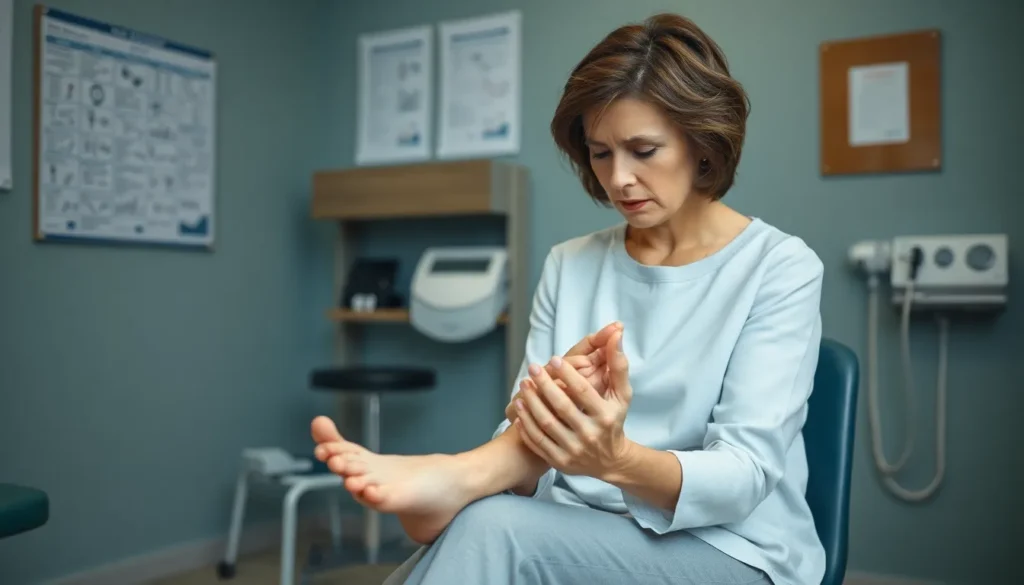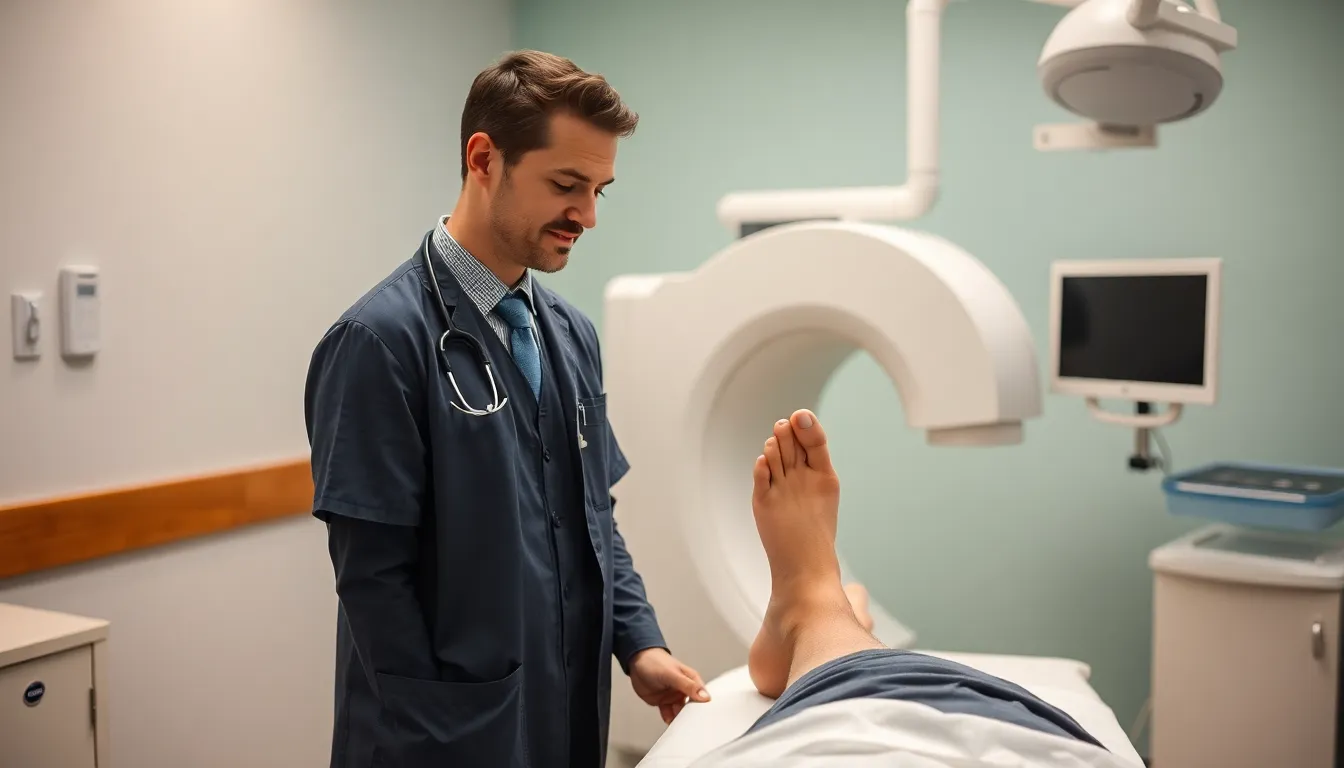
Pavatalgia disease might sound like a fancy dish at a five-star restaurant, but it’s far from gourmet. This pesky condition can leave folks feeling like they’ve been hit with a bad case of the “ouchies” in their feet. If you’ve ever wondered why your feet are throwing a tantrum, you’re not alone. Diagnosing pavatalgia is crucial for getting back on your feet—literally!
Understanding the signs and symptoms is the first step in this diagnostic dance. From sharp pains to that nagging discomfort that just won’t quit, knowing what to look for can save you from unnecessary trips to the doctor. So grab your detective hat and let’s unravel the mystery of pavatalgia disease together! With the right approach, you’ll be strutting your stuff again in no time.
How to Diagnose Pavatalgia Disease
Pavatalgia disease manifests as significant foot pain and discomfort. Recognizing its characteristics aids in effective management.
Definition and Symptoms
Pavatalgia refers to intense foot pain stemming from various underlying issues. Symptoms typically include sharp, stabbing sensations and persistent discomfort. Individuals often report difficulty in walking or standing for extended periods. Swelling or tenderness may accompany these sensations, exacerbating daily activities. Patients might also experience stiffness, especially after periods of inactivity. Identifying these symptoms early is crucial for timely diagnosis and treatment.
Causes and Risk Factors
Multiple factors contribute to the onset of pavatalgia. Overuse injuries frequently lead to conditions such as plantar fasciitis or tendonitis. Extra weight on the feet from obesity increases pressure, intensifying pain. Genetic predispositions can heighten susceptibility to foot problems. Certain professions requiring prolonged standing also elevate risk levels. Inactivity may predispose individuals to structural imbalances worsening the condition. Understanding these factors enables better prevention and management strategies.
Diagnostic Methods

Diagnosing pavatalgia disease involves several key methods to accurately assess the condition. Healthcare professionals often start with a physical examination, followed by imaging tests to gather more information.
Physical Examination
A physical examination allows healthcare providers to observe foot mechanics and assess tenderness. They typically check for swelling or pain in specific areas. Additionally, the provider may evaluate the patient’s gait to identify changes in walking patterns. Range of motion tests help determine flexibility and mobility limitations. If signs of pavatalgia are present, further diagnostic methods are considered.
Imaging Tests
Imaging tests play a critical role in diagnosing pavatalgia. X-rays help visualize bone structure, revealing fractures or alignment issues. MRI scans provide detailed images of soft tissues, identifying inflammation or damage to ligaments and tendons. CT scans may also be used for comprehensive views of the foot, aiding in diagnosis. By combining information from physical examinations and imaging tests, healthcare providers can formulate effective treatment plans tailored to each patient’s needs.
Laboratory Tests
Laboratory tests play a crucial role in diagnosing pavatalgia disease. Through various tests, healthcare professionals gather valuable information to guide treatment options.
Blood Tests
Blood tests assess inflammation markers that indicate underlying conditions contributing to foot pain. Elevated levels of substances like C-reactive protein (CRP) and erythrocyte sedimentation rate (ESR) suggest inflammation that may require further investigation. Blood tests can also identify autoimmune disorders that might link to pavatalgia. Specialists often examine vitamin D and calcium levels to rule out deficiencies that could exacerbate pain. By analyzing these results, healthcare providers gain insights into possible causes of symptoms.
Genetic Testing
Genetic testing aids in understanding hereditary factors related to pavatalgia. Specific gene variations can explain individual susceptibility to conditions leading to foot pain. Testing may reveal mutations linked to connective tissue disorders. Family history combined with genetic findings can lead to a more comprehensive diagnosis. When clinicians identify relevant genetic markers, they tailor treatment plans accordingly. Genetic insights can enhance preventative strategies, improving long-term management of the disease.
Differential Diagnosis
Diagnosing pavatalgia requires careful consideration of other conditions that may cause similar symptoms. Accurate differentiation ensures appropriate treatment and management.
Conditions with Similar Symptoms
Several conditions present symptoms mirroring pavatalgia. Plantar fasciitis often causes heel pain, particularly with initial steps in the morning. Metatarsalgia identifies pain in the ball of the foot, often linked to overuse or high-impact activities. Tarsal tunnel syndrome can lead to tingling sensations due to nerve compression, while arthritis may cause general foot pain, swelling, and stiffness. Additionally, Achilles tendinitis results in pain along the heel and back of the foot, particularly during movement. Recognizing these conditions helps in effectively distinguishing them from pavatalgia, leading to a more accurate diagnosis.
How to Distinguish Pavatalgia
Distinguishing pavatalgia from other foot disorders requires a thorough approach. A focused history of symptoms aids in identifying the specific nature of the pain. Physical exams determine tenderness locations and assess gait abnormalities. Imaging tests, like X-rays and MRIs, provide crucial insights into structural issues and inflammation. Healthcare providers also consider the patient’s activity levels, weight, and general health, which may influence symptoms. Observing response to conservative treatments can further clarify whether pavatalgia is the underlying cause. Gathering detailed information leads to a precise diagnosis and suitable management strategies.
Treatment Options
Effective management of pavatalgia involves both medical and lifestyle approaches to alleviate pain and improve function.
Medical Management
Healthcare providers often prescribe nonsteroidal anti-inflammatory drugs (NSAIDs) to reduce pain and swelling associated with pavatalgia. Corticosteroid injections may also help relieve localized inflammation, enhancing comfort for patients. Physical therapy plays a critical role in recovery, focusing on exercises that improve strength and flexibility in the affected area. Orthotic devices, like custom insoles, provide support and redistribute pressure on the foot. When conservative treatments fail, surgical options may be considered to address structural issues, ensuring more permanent relief. Regular follow-ups help monitor progress and adjust treatment plans as needed.
Lifestyle Changes
Implementing lifestyle changes proves beneficial for managing pavatalgia. Maintaining a healthy weight decreases excess strain on the feet, potentially reducing pain. Engaging in low-impact activities, such as swimming or cycling, allows for cardiovascular exercise without exacerbating foot discomfort. Footwear selection remains crucial; supportive shoes with adequate cushioning help prevent further injury. Stretching before and after physical activities enhances flexibility, keeping muscles and ligaments healthy. Stress management techniques, like yoga or meditation, foster overall well-being, contributing to pain relief and improved quality of life.
Medical Interventions and Lifestyle Adjustments
Diagnosing pavatalgia disease requires a comprehensive approach that combines physical examinations with advanced imaging and laboratory tests. Early recognition of symptoms plays a vital role in managing this condition effectively. By understanding the various causes and risk factors associated with pavatalgia, individuals can take proactive steps toward prevention and treatment.
Healthcare providers must differentiate pavatalgia from similar conditions to ensure accurate diagnosis and appropriate care. With tailored treatment plans that include both medical interventions and lifestyle adjustments, patients can find relief from pain and regain their mobility. Embracing a holistic approach empowers individuals to navigate the challenges of pavatalgia and enhance their quality of life.












